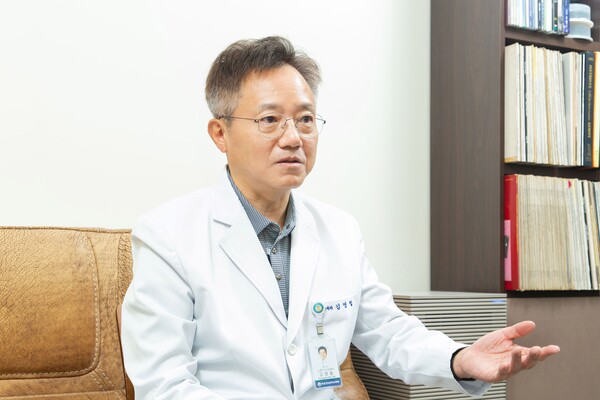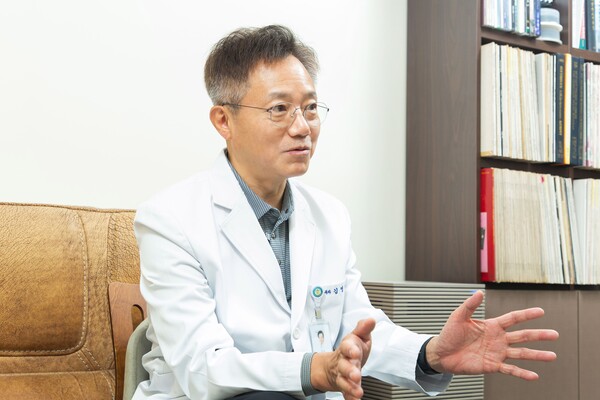Lung cancer, known for its high fatality rate with a five-year relative survival rate of only 36.8 percent, presents unique challenges in early detection due to the absence of sensory nerves in the lungs.
Consequently, diagnoses often occur in advanced stages, resulting in a grim prognosis. Notably, 30 to 40 percent of non-small cell lung cancer (NSCLC) patients, which constitutes 85 percent of all lung cancer cases, develop the condition due to epidermal growth factor receptor (EGFR) gene mutations. These EGFR mutations are more prevalent in the Asian population, including Koreans, making anti-cancer drugs targeting EGFR mutations a subject of significant interest.
In Korea, two licensed targeted therapies are available for the treatment of EGFR-mutated NSCLC are AstraZeneca's Tagrisso (osimertinib) and Yuhan’s Leclaza (lasertinib). These medications belong to the third generation of therapies designed for EGFR-mutated NSCLC and are administered when patients exhibit resistance to first- or second-generation targeted treatments.
Tagrisso and Lexarza have recently been proposed for inclusion in health insurance coverage as first-line treatments, and both have successfully cleared the Health Insurance Review and Assessment Service (HIRA)'s Drug Reimbursement Committee. They are currently awaiting drug price negotiations and review by the Ministry of Health and Welfare's Health Insurance Policy Review Committee.
Leclaza was approved as a first-line treatment by the Ministry of Food and Drug Safety in June after proving its effectiveness and safety in the global phase 3 clinical trials. Since then, Yuhan has been implementing an early access program (EAP) to provide free treatment to lung cancer patients.
Korea Biomedical Review interviewed Professor Kim Young-Chul Kim, a pulmonology expert at Chonnam National University Hwasun Hospital, to discuss the current state of EGFR-mutated NSCLC treatment, the shifts in prescribing practices resulting from the full implementation of Leclaza's EAP, and strategies for preventing lung cancer.

Question: The treatment landscape for lung cancer has evolved significantly in recent years, marked by the approval of the third-generation targeted therapy Leclaza for first-line treatment. As a healthcare professional dealing with lung cancer, a condition associated with lower survival rates compared to other cancers, this transformation in the treatment paradigm must be profoundly rewarding, wouldn't you agree?
Answer: Although the widespread availability of first-line third-generation targeted therapies is currently hindered by the absence of health insurance coverage, the expansion of treatment options for physicians managing lung cancer patients is indeed a positive development. From the perspective of internists, having a broader array of drugs at our disposal is an invaluable asset, making it a very much welcomed addition to our treatment options.
In particular, Leclaza was shown to be more effective in the L858R substitution mutation (L858R) population, which has a relatively poor prognosis based on the LASER301 trial. We believe this will be an important prescribing factor in the upcoming release of overall survival (OS) data from the LASER301 trial.
Q: Leclaza, alongside the third-generation Tagrisso, has successfully navigated the drug reimbursement review process and is poised to secure health insurance coverage as a first-line treatment for EGFR NSCLC. Notably, Yuhan has implemented an early access program (EAP) for Leclaza, providing access to all patients while awaiting reimbursement approval. What is your perspective on this unique approach?
A: Before the introduction of Leclaza, there was an available treatment option in Tagrisso. However, its active use was hampered due to the lack of health insurance coverage. This situation was particularly challenging in rural areas where a higher proportion of individuals faced economic constraints. As a result, patients often resorted to utilizing first- and second-generation therapies, despite their higher side effect profiles and shorter duration of efficacy compared to third-generation targeted therapies, mainly because these earlier options were covered by insurance.
Since Yuhan initiated the comprehensive EAP for Leclaza. In just one month, we observed a substantial surge in the utilization of Leclaza. While we still present patients with a range of treatment options and encourage them to make informed choices, a considerable number of patients are opting for Leclaza due to its zero cost.
Q: As more effective new drugs make their way into first-line treatments, as seen with the inclusion of Leclaza and Tagrisso, what is your perspective on this trend?
A: There are both advantages and disadvantages to this trend. The primary advantage of using third-generation drugs as a first-line treatment is their extended duration of efficacy when compared to first- and second-generation options. Additionally, third-generation drugs tend to have fewer side effects. First- and second-generation drugs often result in common side effects such as diarrhea, skin rashes, and inflammation around the nails, which can be distressing for patients. However, third-generation drugs are known for having minimal side effects.
The drawback of directly initiating treatment with third-generation drugs is that if a patient develops resistance to them, there are limited alternatives to explore. When a third-generation drug becomes ineffective due to resistance, reverting to first- or second-generation drugs is generally not a viable solution. These earlier-generation drugs tend to be less effective in such cases, with rare exceptions. Consequently, the third generation of targeted therapies is typically reserved for cases where the disease has advanced, and resistance mutations have emerged. At that juncture, the treatment approach may shift toward general cytotoxic antitumor drugs.

Q: How are treatment outcomes in the real world compared to the primary clinical outcomes of Leclaza?
A: It's too early to judge the effectiveness of the EAP at the point of care. However, with targeted therapies, it is not uncommon to see a response within a month or two of prescribing, such as a significant reduction in tumor size or improvement in symptoms experienced by patients.
Moreover, third-generation drugs exhibit a more prolonged duration of efficacy compared to first and second-generation alternatives, with minimal side effects like diarrhea and skin rash. This leads us to anticipate a relatively smooth integration of these drugs into clinical practice.
Certainly, it's crucial to vigilantly monitor and address adverse events associated with drugs like Tagrisso, which can include issues like numbness in the hands and feet and cardiac toxicity. For Leclaza, management involves dose adjustments or the addition of nerve pain medications in cases where patients experience numbness. This approach helps ensure patient safety and optimize their treatment experience.
Q: Wouldn't a lower dose be less effective against cancer?
A: This could indeed be the case, and as more data accumulates, it may become evident that effectiveness can be sustained with dose reductions. As of now, relying primarily on laboratory data, significant dose reduction is not extensively recommended. However, with increasing experience in administering the treatment, it is likely that we will gain more confidence in managing it effectively without compromising its benefits.
Q: The Korean sub-analysis in the LASER301 trial was noteworthy because there were no Korean data in the first-line setting. Can you share the results?
A: Tagrisso has faced challenges in the reimbursement process, mainly because of the absence of valid overall survival (OS) data in the Asian sub-analysis. However, Leclaza holds a strong case for prescription in Korean patients. This is attributed to the fact that approximately one-third of the LASER301 trial participants were Koreans, and consequently, there is access to Korean sub-analysis data, providing a solid rationale for its use in the Korean patient population.
Q: Why do you believe there are elevated expectations for the MARIPOSA trial, set to be unveiled at the European Society for Medical Oncology (ESMO) 2023, given the ongoing combination therapy trials for EGFR-targeted therapies?
A: The MARIPOSA trial will be presented at ESMO 2023 with specific clinical results, but the top-line presentation was positive. Depending on the specific clinical results, I think we could see a shift in practice in the future. However, because it is a targeted therapy-targeted therapy combination, the effectiveness may be better, but there are also side effects to deal with, so depending on the future results, we will be able to judge whether it is better to use it sequentially or whether it is more advantageous to use it in combination from the beginning.
Related articles
- Korean pharma firms gear up for ESMO 2023, Europe's premier cancer conference
- [Interview] Tagrisso offers a new option for 1st-line treatment of stage 4 lung cancer
- Yuhan's NSCLC drug Leclaza passes first hurdle for reimbursement expansion
- Leclaza shows benefits of homegrown new drug
- Yuhan's Leclaza aims to enter US market based on MARIPOSA study’s success
- ‘Leclaza shows efficacy on patients with lung cancer metastasized to brain’
- Yuhan secures full approval for Leclaza as 1st-/2nd-line treatment for NSCLC

